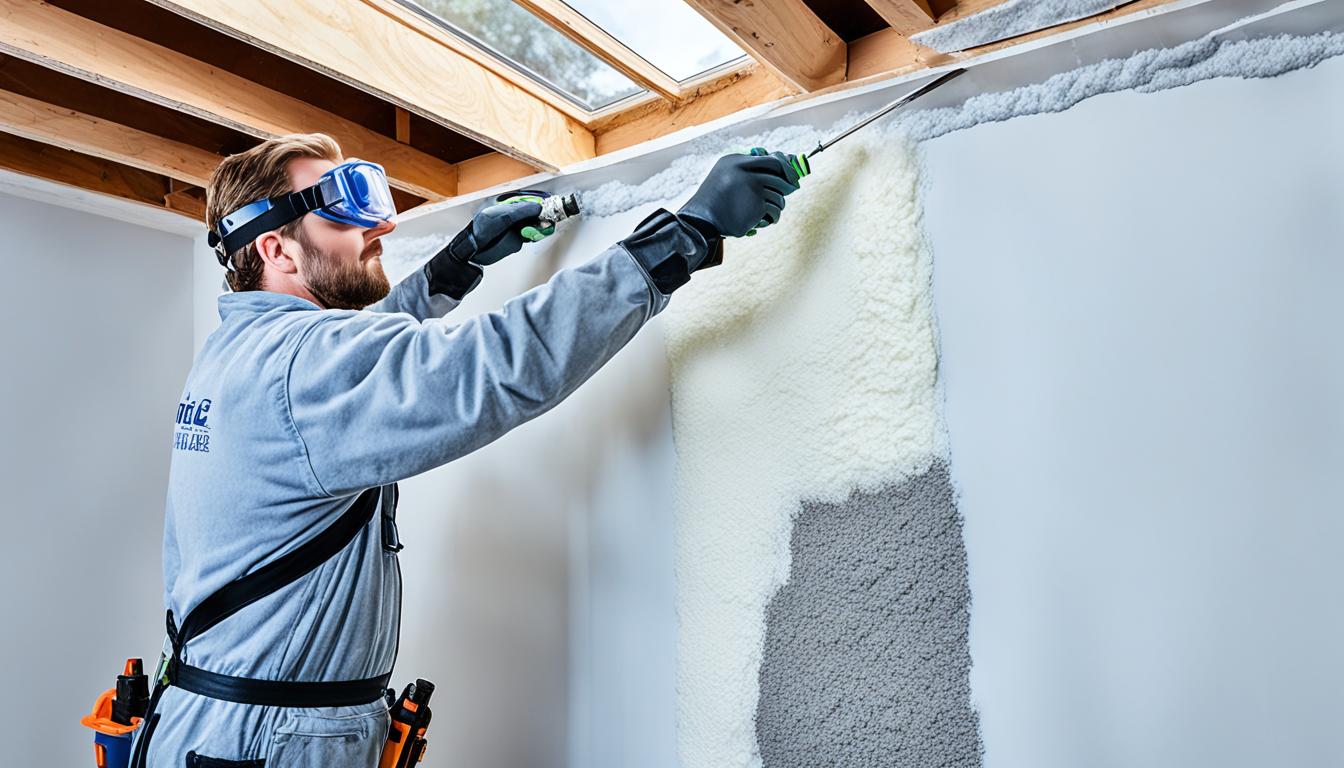DIY Spray Foam Insulation for Existing Walls
Do you want to make your home more energy efficient and save money? Consider VB Insulation's DIY spray foam for existing walls. Our solution helps eliminate drafts and lower energy costs. We'll show you how to do it with simple, eco-friendly methods.

Key Takeaways:
- Discover how DIY spray foam insulation for existing walls can improve energy efficiency.
- Learn why VB Insulation is the go-to choice for cost-effective and eco-friendly insulation.
- Explore the step-by-step process of insulating your walls with spray foam.
- Uncover the advantages of DIY spray foam insulation for older homes.
- Find out how DIY insulation can be a game-changer for your energy bills.
Understanding the Importance of Wall Insulation
Before you start DIY spray foam insulation, understand why wall insulation is essential. Good wall insulation makes your home more energy-efficient and comfortable. This means less heat loss and lower energy use, creating a cozy space indoors.
Homeowners have many wall insulation options. It would help if you looked at different types to find what fits your needs and budget. Choices range from old-fashioned fiberglass to modern Closed Cell spray foam insulation.
Knowing various home insulation methods is crucial to making the right choice. Each has its pros and cons. For instance, you can choose batt, blown-in, or rigid foam insulation based on what works best.
For old walls, look at insulation that's both effective and budget-friendly. These homes might have issues like air leaks and outdated insulation. Solutions to these problems make old homes more energy-efficient and comfortable.
Read More: How to Insulate Existing Walls: Comprehensive Guide for Homeowners
The DIY Spray Foam Insulation Method
Insulation is vital for an energy-smart home. It lessens heating and cooling costs, boosts coziness, and shrinks carbon footprint. Here, we'll show you how to use spray foam to insulate your home's walls. This DIY project helps you make your house more energy efficient.
Home Insulation Tips
First, consider some tips for insulating your home on your own.
- Inspect your walls for any gaps or missing insulation.
- Wear protective gear like Safety Googles and a Safety Suit to stay safe.
- Clean walls well to remove any dirt or old insulation.
- Determine how much spray foam you need based on wall size and desired insulation level.
Insulation Techniques
You can choose from a few methods for insulating with spray foam.

- Spot Insulation: This method targets specific spots like gaps with spray foam.
- Coverage Insulation: It involves spraying the whole wall, ensuring even insulation.
- Multiple Layers: Add more layers for better insulation, letting each dry before the next.
Read More: How to DIY Spray Foam Insulation: A Beginner's Guide
Best Spray Foam Insulation Method
The proper spray foam method depends on your needs and your walls. VB Insulation's kit is a top pick.
This kit is perfect for homeowners wanting to upgrade their wall insulation. It has all you need, from materials to safety gear. With VB Insulation, you can seal your walls well for significant energy savings.
Advantages of DIY Spray Foam Insulation
DIY spray foam insulation has many benefits for old walls. It helps make older homes more energy efficient, reducing energy waste and cutting down on bills.
This method is a smart choice for improving your walls' insulation. It creates a barrier that air and heat can't easily pass through, saving you a lot of energy all year.
This type of insulation works on all sorts of old or new walls. It sticks well, expands to fill in gaps, and seals cracks, so your home is better protected and uses energy more efficiently.
Doing it yourself can make your home more energy efficient. Just be sure to use good materials and follow the right steps, like choosing VB Insulation. This will result in great improvements in your home.
A big plus of DIY spray foam insulation is its versatility. You can use it in any part of your house, helping keep noise out and making your home more peaceful.
It's a wise long-term investment because it saves energy and money. By not overworking your HVAC system, you also help it last longer. This means fewer repairs and replacements down the road.
Read More: DIY Spray Foam Insulation Cost
Take the Next Steps in Energy Efficiency
If the walls of your old house aren't well sealed, you're losing energy. But with DIY spray foam from VB Insulation, you can fix this. It's your key to a more energy-efficient home.

Don't delay. Start today and see how a well-insulated home improves your life. You'll stay cozy year-round and save on energy.
Read More: Spray Foam Cost Per Square Foot
Conclusion
DIY spray foam insulation is excellent for making walls more energy-efficient. When you compare different materials and costs, you can choose what's best for your home. Also, knowing how to insulate yourself gives you more power over your home's improvements.
VB Insulation is well-known for helping you make your home cozy and efficient. They offer many insulation choices, including special products, making it easy to find what you need for your project.
Start insulating your walls with foam to enjoy significant benefits. It will use less energy, reduce bills, and improve your home. VB Insulation will support you, making insulating your walls a rewarding project for your home.
Read More: Cost of foam insulation in existing walls
FAQ
What is DIY spray foam insulation?
DIY spray foam insulation is a way to make walls more energy-efficient by adding special foam. People use it to keep their homes warm or cool and to block out noise.
Why should I choose DIY spray foam insulation for my existing walls?
Choosing DIY spray foam can make your house more comfortable and save money on energy. It's good for old and new homes alike, and it cuts down on noise, making it a smart choice for many homeowners.
Can I install spray foam insulation myself?
Yes, you can install it yourself. Just remember to keep safe and understand how to apply it. It's best to use kits made for DIY projects.
How do I insulate my existing walls with spray foam?
To do this, first remove the old insulation and clean the walls. Next, add the insulation using a foam kit. Read and follow the kit's instructions. Let the foam dry entirely before finishing up.
Is DIY spray foam insulation a cost-effective solution?
In the long term, yes. Even though it might cost more at first, the energy savings and the value it adds to your home are worth it.
Will DIY spray foam insulation work for all types of walls?
Mostly, yes. It can go on wood, concrete, and drywalls. But always check your walls first. If you need more clarification, get advice from a pro.




